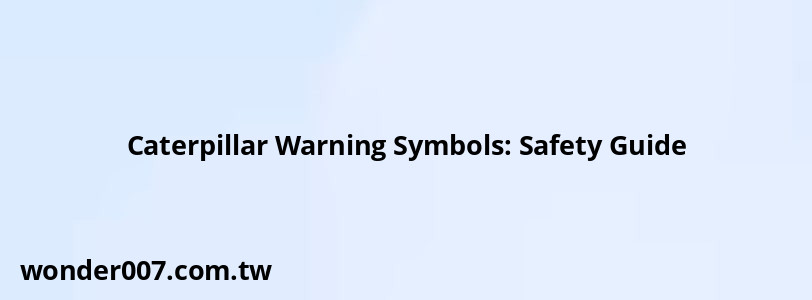Caterpillar Warning Symbols: Safety Guide

Caterpillar, a leading manufacturer of construction and mining equipment, uses a comprehensive system of warning symbols to ensure the safety of operators and maintenance personnel. These symbols are crucial for identifying potential hazards and preventing accidents.
Safety Alert Symbol
The Safety Alert Symbol is the foundation of Caterpillar's warning system. It appears as a triangle with an exclamation point inside. This symbol precedes all safety messages and indicates:
- Attention!
- Become Alert!
- Your Safety is Involved!
When you see this symbol, it's essential to pay close attention to the accompanying message, which explains the specific hazard.
Signal Words
Caterpillar uses three primary signal words to indicate the severity of potential hazards:
- DANGER: Indicates an imminent hazardous situation that, if not avoided, will result in death or serious injury.
- WARNING: Indicates a potentially hazardous situation that, if not avoided, could result in death or serious injury.
- CAUTION: Indicates a potentially hazardous situation that, if not avoided, may result in minor or moderate injury.
These signal words appear in conjunction with the Safety Alert Symbol and are typically followed by specific instructions or warnings.
Common Warning Symbols
Caterpillar uses a variety of pictographs to represent different types of hazards or safety instructions. Some common symbols include:
- Engine Oil Pressure: Indicates low engine oil pressure
- Engine Coolant Temperature: Warns of high engine coolant temperature
- Fuel Filter Restriction: Signals a restriction in the fuel filter
- Air Filter Restriction: Indicates a restriction in the air filter
- Water in Fuel: Warns of water contamination in the fuel system
Interpreting Warning Lights
When operating Caterpillar equipment, it's crucial to understand the meaning of different warning lights:
- Red Light: Indicates a critical system fault requiring immediate shutdown
- Yellow Light: Signals a caution, suggesting the machine should be operated with care
- Green Light: Shows that a system is functioning normally
Importance of Proper Training
Understanding and responding to Caterpillar warning symbols is vital for safe operation. Operators should:
- Read the manual: Always review the Operation and Maintenance Manual before using any Caterpillar equipment.
- Stay alert: Continuously monitor warning indicators during operation.
- Follow procedures: Adhere to all safety procedures and recommendations provided by Caterpillar.
- Seek assistance: If unsure about a warning symbol or indicator, consult with a qualified technician or Caterpillar representative.
Maintenance and Safety
Proper maintenance is crucial for ensuring the reliability of warning systems. Regular checks should include:
- Verifying that all warning labels are intact and legible
- Testing warning lights and indicators
- Ensuring sensors and monitoring systems are functioning correctly
Remember, never operate Caterpillar equipment if you're unsure about the meaning of a warning symbol or if safety systems appear compromised.
FAQs About Caterpillar Warning Symbols
- What should I do if a red warning light appears during operation?
Immediately stop the machine, shut down the engine, and consult the operator's manual or a qualified technician before resuming operation. - Are Caterpillar warning symbols standardized across all their equipment?
While many symbols are consistent, always refer to the specific manual for your equipment model, as there may be variations or additional symbols. - How often should warning systems be checked?
Perform a visual inspection of warning indicators before each use and conduct thorough checks according to the maintenance schedule in your operator's manual.
By understanding and respecting Caterpillar warning symbols, operators can significantly reduce the risk of accidents and ensure a safer working environment for everyone involved in equipment operation and maintenance.
Related Posts
-
Chevy Truck Steering Column Diagram: A Comprehensive Guide
28-01-2025 • 129 views -
Brake Light Switch: Replacement Guide for 2013 Nissan Altima
28-01-2025 • 118 views -
Toyota Camry AC Drain Hose Location Guide
30-01-2025 • 183 views -
Airbag Warning Light: Safety Risks and What to Do
28-01-2025 • 121 views -
2013 Hyundai Sonata: Essential Oil Filter Guide
29-01-2025 • 133 views
Latest Posts
-
Rear Brake Caliper Piston Won't Compress
01-02-2025 • 258 views -
How To Turn Off Paddle Shifters Mercedes
01-02-2025 • 274 views -
2015 Chevy Traverse AC Recharge Port Location
01-02-2025 • 291 views -
Are O2 Sensors Covered Under Warranty
01-02-2025 • 280 views -
Power Steering Fluid Leak On Passenger Side
01-02-2025 • 321 views
Popular Posts
-
2015 VW Passat Oil Consumption Issues Explained
26-01-2025 • 520 views -
EPC Light: Understanding Causes and Solutions
26-01-2025 • 880 views -
V12 Engine Costs: What You Need to Know
26-01-2025 • 524 views -
EPC Warning Light: What It Means for Your Vehicle
27-01-2025 • 534 views -
Power Steering and ABS Light On: Causes and Solutions
27-01-2025 • 472 views
